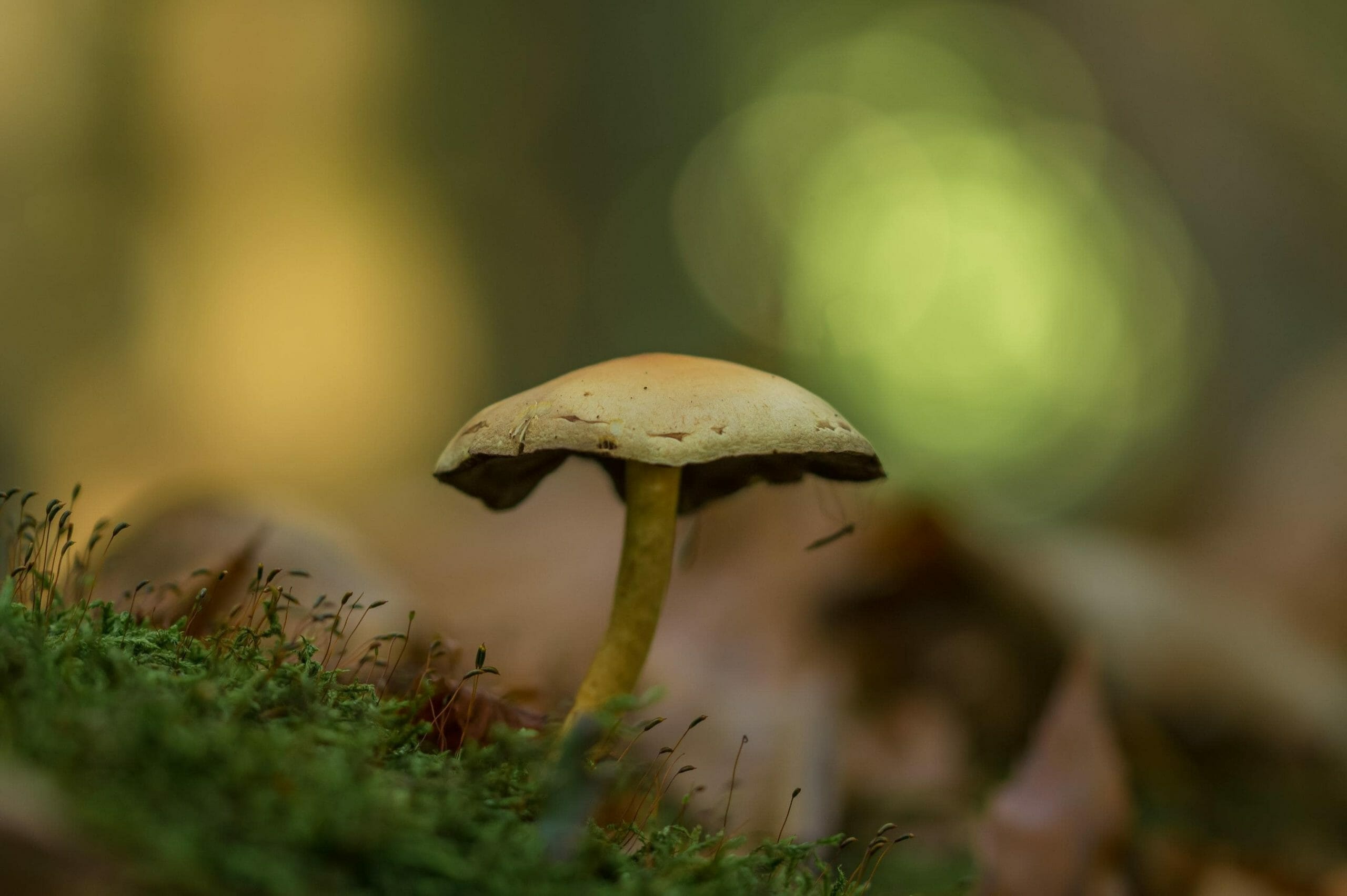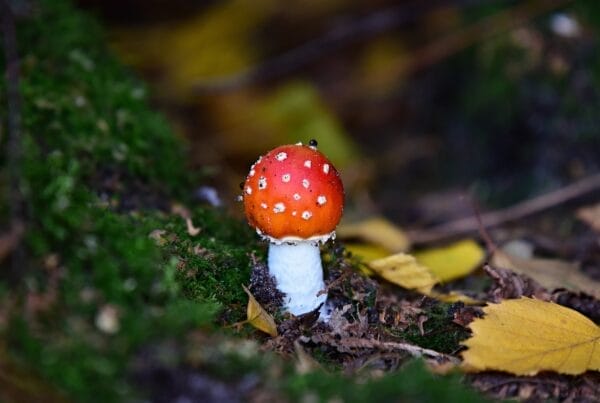Psilocybe Cubensis is a type of magic mushroom that contains the psychoactive compounds psilocybin and psilocin. These compounds are responsible for inducing altered perception, mood changes, and mystical experiences. Recent research suggests that Psilocybe Cubensis may have therapeutic potential for treating mental health conditions, addiction, and existential anxiety.
The psychoactive effects of this mushroom have gained notoriety, as it has been utilized for medicinal and spiritual purposes for centuries. In more recent times, its use has grown in popularity within recreational drug culture.
Table of Contents
- A Brief History
- Psilocybe Cubensis and Its Influence on Art
- Writers and Visual Artists who find their creativity sparked by psilocybin
- A Scientific Narrative
- What Experts Have to Say?
- Other Related Studies Supporting the Potential of Psilocybe Cubensis
- The Wellness and Healing Benefits of Psilocybe Cubensis
- Cultivation
- The Future of Psilocybe Cubensis in the Canadian Market
- Online Dispensaries: The Best Option for Shroom Buyers
- Conclusion
- Frequently Asked Questions
A Brief History
In the 1950s, R. Gordon Wasson, an ethno-mycologist, visited Mexico and participated in a mushroom ceremony with the Mazatec people. Wasson later published an article in Life magazine about his experiences, which introduced Psilocybe mushrooms to the Western world.
Its uses can be traced back to ancient civilizations in Central America. The Aztecs, for example, used mushrooms containing psilocybin in their religious ceremonies.
Indigenous tribes in Central and South America have been using them for centuries in traditional medicine and spiritual practices. Psilocybe mushrooms are believed to have originated in these regions, and the earliest recorded use of them dates back to pre-Columbian times. These tribes used mushrooms for their hallucinogenic and healing properties.
Psilocybe Cubensis and Its Influence on Art
It is a species of psychedelic mushroom that has been used for centuries by indigenous cultures in Mesoamerica for its hallucinogenic properties. It contains psilocybin, a psychoactive compound that alters perception, mood, and thought. While the effects of psilocybin on the human brain have been widely studied in recent years, less is known about how this substance has influenced art and culture throughout history.
Psilocybin’s influence on art is primarily due to its ability to induce altered states of consciousness that can lead to profound experiences of beauty, interconnectedness, and transcendence. This has led many artists, musicians, and writers to experiment with psilocybin and other psychedelics as a way to expand their creativity and deepen their understanding of the world.
One of the most famous examples of this is the work of the American writer and counterculture figure, Terence McKenna. McKenna was an outspoken advocate for the use of psychedelics and believed that they held the key to unlocking the mysteries of the universe. His writing and lectures were heavily influenced by his experiences with psilocybin and other hallucinogens, which he described as “plant teachers” that could guide humans toward a deeper understanding of reality.
Writers and Visual Artists who find their creativity sparked by psilocybin
One of the most famous examples is the Swiss artist and mystic, Albert Hofmann. Hofmann was the chemist who first synthesized LSD, another powerful psychedelic, and he was also a passionate advocate for the use of psilocybin. In his later years, Hofmann began to explore the relationship between psychedelics and spirituality, and his paintings often depicted mystical and visionary experiences.
Another artist who was heavily influenced by psilocybin was the American painter and sculptor, Alex Grey. Grey’s work is characterized by its intricate, highly detailed style and its exploration of themes related to consciousness, spirituality, and the human body. Grey has credited his use of psychedelics, including psilocybin, with helping him to develop his unique artistic style and to deepen his understanding of the world.
Beyond individual artists, psilocybin has also had a significant influence on broader cultural movements. One of the most well-known examples is the counterculture movement of the 1960s, which was characterized by its rejection of mainstream values and its embrace of alternative lifestyles and spirituality.
Many members of the counterculture experimented with psychedelics, including psilocybin, as a way to explore their inner selves and connect with others on a deeper level.
A Scientific Narrative
Psilocybin and psilocin are the main psychoactive compounds in Psilocybe Cubensis. Psilocybin is a prodrug, which is converted to psilocin once it enters the body. Psilocin has a structure similar to serotonin and acts on serotonin receptors in the brain.
Biology
Psilocybe Cubensis is a type of fungi that grows naturally in tropical and subtropical regions, including South America, Mexico, and parts of Asia. The mushroom is typically found in damp, humid environments such as cow pastures and forests. They belong to the family Hymenogastraceae and has a distinctive appearance, with a cap that can range from 1-8 cm in diameter and a stem that can grow up to 15 cm in height.
Chemistry
This contains psilocybin, a tryptamine compound that produces psychoactive effects. When consumed, psilocybin is metabolized into psilocin, which binds to serotonin receptors in the brain and causes changes in perception, mood, and thought processes. However, psilocybin is classified as a Schedule I substance in the United States.
What Experts Have to Say?
Magic mushrooms have been studied extensively by laboratory and science experts for their chemical composition and effects on the human body. Research has shown that the active compounds in the genus Psilocybe Cubensis are psilocybin and psilocin, which are both classified as tryptamines.
In a study conducted by the Beckley Foundation, a UK-based think tank that conducts research on consciousness and drug policy, researchers found that psilocybin in Psilocybe Cubensis binds to serotonin receptors in the brain, leading to altered states of consciousness and perception. This effect is similar to the effects of other psychedelics, such as LSD and DMT.
Other Related Studies Supporting the Potential of Psilocybe Cubensis
The same study also found that psilocybin has the potential to induce mystical experiences, which are characterized by a sense of unity, transcendence, and ineffability. These experiences have been shown to have long-term positive effects on mental health, including reduced symptoms of anxiety and depression.
Other studies have shown that they may also have neuroprotective properties. In a study conducted by researchers at the University of South Florida, psilocybin was found to stimulate the growth of new brain cells in rats, a process known as neurogenesis. This effect may have potential implications for the treatment of neurological disorders such as Alzheimer’s disease and depression.
The Wellness and Healing Benefits of Psilocybe Cubensis
Their uses for wellness and healing has been documented throughout history. In traditional cultures, these mushrooms were used for spiritual and medicinal purposes, often in the form of tea or as part of a ritual ceremony. Today, researchers are exploring its potential benefits for treating a variety of mental health disorders.

One of the most well-known benefits is its ability to induce profound mystical experiences. Research has shown that these experiences can have significant positive effects on mental health, including reductions in symptoms of anxiety, depression, and addiction.
Psychological Effects
The psychological effects can vary depending on the dose and individual. Some common effects include:
- Euphoria
- Altered perception of time and space
- Intensified emotions
- Enhanced creativity
- Changes in thought patterns
- Spiritual experiences
- Increased introspection
Note: The effects of consuming dried mushrooms can be quite potent, and it is recommended to begin with a small amount of one to three grams before attempting a stronger experience.
Cultivation
They can be cultivated at home with relative ease. The process involves the following steps:
Substrate Preparation
The first step in cultivation is preparing the substrate. The substrate is the material that the mushrooms will grow on. Common substrates include rice flour, vermiculite, and brown rice.
Inoculation
Once the substrate is prepared, it is sterilized to kill any bacteria or fungi that may compete with the Psilocybe cubensis. The sterilized substrate is then inoculated with spores or mycelium.
Incubation
After inoculation, the substrate is placed in a warm, dark place to incubate. During incubation, the mycelium will colonize the substrate.
Fruiting
Once the substrate is fully colonized, it is time to induce fruiting. This involves exposing the substrate to light and humidity.
Recreational Use
The most commonly consumed for its psychoactive effects. It is usually ingested orally, either by eating fresh or dried mushrooms or by brewing them into tea. The effects of psilocybin-containing mushrooms are dose-dependent, with higher doses resulting in more intense experiences.
During the 4-6 hour period after ingestion of psilocybin, users may begin experiencing a range of effects. These can include alterations in their perceptions of time and space, changes in sensory perception, mood and thought processes, and potentially profound spiritual or mystical experiences.
Party Use
Magic mushrooms are frequently consumed in social settings, particularly at events such as music festivals and raves. Users report heightened senses and a feeling of interconnectedness with their surroundings. It is a popular choice for recreational or party use due to its ability to increase creativity and spirituality through altered consciousness.
The Future of Psilocybe Cubensis in the Canadian Market
In 2020, Health Canada granted exemptions to several individuals to use psilocybin for medical purposes. This landmark decision has opened the door for the wider legalization of psilocybin and magic mushrooms in Canada. While the recreational use of magic mushrooms is still illegal in Canada, the medicinal use of psilocybin is becoming more widely accepted.
If you’re a fan of magic mushrooms, you know that they can be a bit pricey, especially if you’re buying small quantities. That’s where buying in bulk can save you a lot of money. Cubensis mushrooms, one of the most popular species of psilocybin mushrooms, are often sold in bulk quantities. By purchasing them this way, you can save money and always have some on hand when you want to administer psilocybin mushrooms.
As psilocybin-containing hallucinogenic mushrooms are being decriminalized in some areas, more people are interested in their potential benefits, including the Mexican hallucinogenic mushroom. The psilocybin mushroom handbook can be a helpful guide for those seeking to learn more.
Online Dispensaries: The Best Option for Shroom Buyers
While Psilocybe Cubensis may be available through traditional retail channels, online dispensaries are quickly becoming the preferred option for buyers in the Canadian market. Online dispensaries offer a wide range of products. They also provide a convenient and discreet way to purchase magic mushrooms from the comfort of your own home.
Online dispensaries also provide buyers with the opportunity to research and learn about different strains and their effects. This information can help buyers make informed decisions about which strain is best for their needs.
Online dispensaries offer a safe and secure way to purchase Psilocybe Cubensis. They use secure payment methods and discreet packaging to ensure that the buyer’s personal information and the contents of the package remain confidential.
Conclusion
Magic mushrooms are a type of psilocybin-containing mushroom that belongs to the psilocybe genus. They are one of the easiest psilocybin-containing mushrooms to cultivate, and their psychoactive properties have made them increasingly popular in recent years.
The psilocybin and psilocin levels in these psychoactive mushrooms can vary depending on various factors, such as the strain, growing conditions, and harvesting methods. However, one interesting fact is that the psilocybe cubensis magic mushroom stain blue when bruised, a characteristic that sets them apart from other wild mushrooms.
There are also numerous resources available, such as the Psilocybe Mushroom Handbook and the Psilocybin Mushroom Bible, which provide detailed information on various of psilocybin mushrooms magic mushroom and species.
With the increasing interest in the potential of psilocybin-containing mushrooms for healing and self-exploration, there has been a movement towards decriminalizing their use. Taking a holistic perspective, many individuals are exploring the potential of psilocybe cubensis mushrooms as a tool for personal growth, spiritual exploration, and mental wellness.
Frequently Asked Questions
What are some common nicknames for Psilocybe cubensis?
Some common nicknames include “magic mushrooms,” “shrooms,” and “golden teachers.”
How long do the effects last?
The effects typically last for 4 to 6 hours, although this can vary depending on the dosage and individual metabolism.
How should Psilocybe cubensis be consumed?
It can be consumed fresh or dried and is often eaten raw, brewed into tea, or added to food.
What are some potential benefits of using Psilocybe cubensis?
It has been used for various purposes, including spiritual exploration, creativity enhancement, and as a potential treatment for depression and anxiety.






